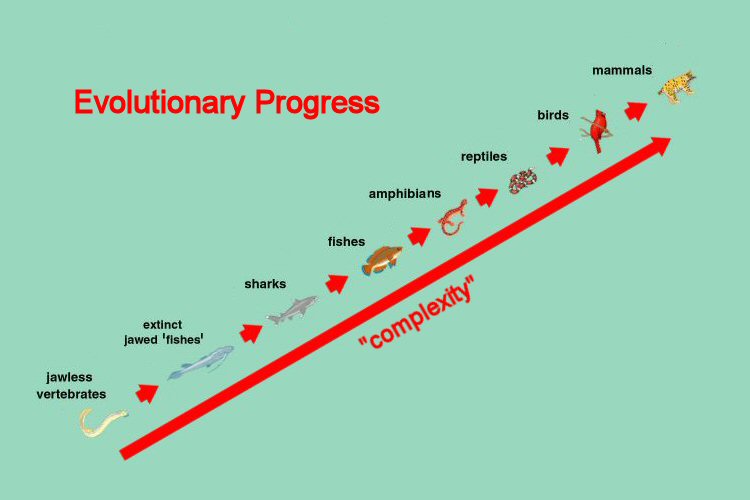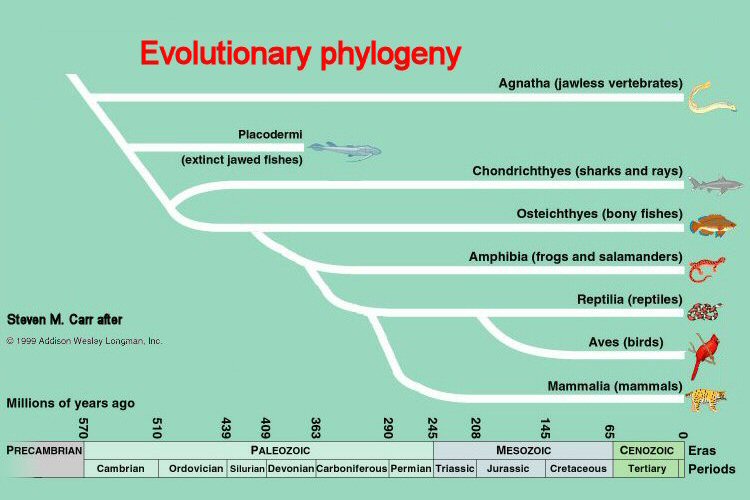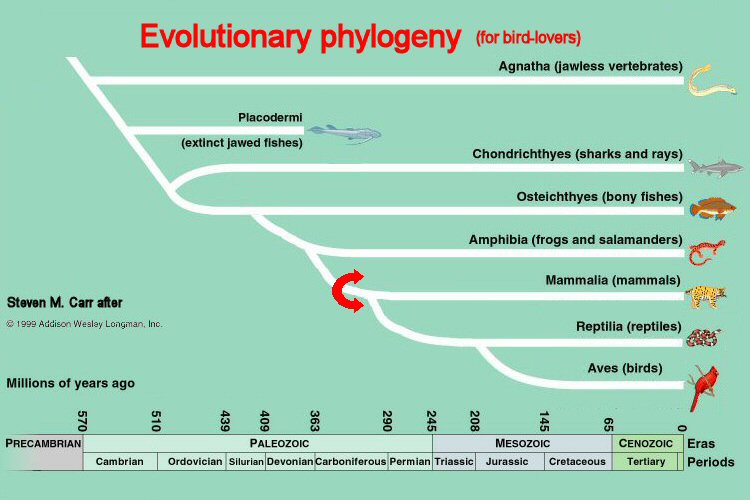 Evolving
portrayals of the evolution of Vertebrate classes
Evolving
portrayals of the evolution of Vertebrate classes
Creatures in
the Phylum Vertebrata (animals
with backbones) are conventionally placed in seven extant and one
extinct taxonomic Classes, with common names as indicated
above. These classes describe eight recognizable "kinds" of
creatures,
based principally on dichotomies: jawless or jawed "fish-like"
things, cartilaginous or bony "fish," scaleless or scaly
tetrapods, and things with feathers or hair. Evolution is then
popularly viewed as a progressive,
linear transformation from "primitive"
aquatic, fish-like forms to "advanced"
terrestrial forms, with the transition from apes to humans as the endpoint of the sequence. The
scale is implicitly one of increasing complexity or progress moving from
bottom to top, and from left to right. This mirrors the ancient
concept of the Scala Naturae or "Great Chain of Being" that dominated Western thinking
through the early 17th century. This iconography creates false
impressions: for example, that fish evolve into salamanders into
dinosaurs into apes into humans, or that we should expect to find
intermediate "links" in the chain. Implicitly, if mammals
are the most complex animals, then humans are the most complex
mammals, and (obviously) the end-point of the series.
Subsequently, classical taxonomists beginning
in the mid-18th century defined the seven Classes of living
vertebrates by combinations of presence & absence
characters that contributed to their similarity. For
example, reptiles are four-legged scaly creatures,
recognizing that legless snakes evolved from four-legged
ancestors. Feathers and hair are structural modifications of
scales that define birds and mammals,
respectively. Modern Amphibia are four-legged scaleless
creatures, where legless amphisbaenians
evolved from four-legged ancestors, and loss of scales is
a structural modification that permits dermal respiration, which
may have evolved more than once.
In modern taxonomy,
historical evolution is properly viewed as a branching "tree" that describes the phylogeny (relationships in time) of groups
under consideration. The phylogenetic diagram below shows
the phylogeny of the same set of creatures illustrated above, with
a node indicating evolutionary branching of lineages, and
a branch showing evolutionary change along each lineage.
The horizontal scale is explicitly temporal, and shows the time of divergence of each
lineage as indicated by fossil and (or) molecular evidence. Note
that the order from top to bottom (Darwin's "Descent with Modification")
has been arranged to show the same sequence as in the progression
from bottom to top above. However, this is an artifact of laying a
complex, multidimensional structure (reminiscent of a 3-D mobile) flat in two dimensions. Because
every node can be rotated, many alternatives are possible. For
example, the second diagram below rotates the node between Reptilia
/ Aves and Mammalia, which place Birds in the
bottom position. Because each successive branch now descends, this
would emphasize that Aves is the most recently
evolved of the conventional classes, but not necessarily the
most "complex", which is a subjective judgement.
Modern phylogenetic taxonomy assigns names to these evolutionary lineages rather than similar groups, and introduces a variety of unfamiliar names. Each of the six
internal nodes creates another group, with another name, many of
them unfamiliar. The
diagrams below do not include certain lineages, such as those
leading to fish-like coelacanths and lungfish, or
dinosaurs & other large, extinct scaly forms, as well as minority
reptiles such as tuataras
(Sphenodon), turtles, and crocodilians,
which complicate the picture and naming considerably. In
particular, crocodilians and birds are the most closely related
living 'reptiles', as recognized by a diapsid (two-opening)
skull . Mammals are most closely related to another group of
extinct 'reptiles' as indicated by a synapsid (one-opening)
skull. Feathers first appear in terrestrial dinosaurs, and hair in
extinct 'reptilian' ancestors, but allow recognition of modern
birds and mammals as distinct among living animals. As well, the Agnatha
('jawless') are recognized as an artificial group that
comprises two very ancient evolutionary lineages: the hagfish
lineage branched off before the evolution of jaws, and a
second lineage evolved from a jawed ancestor to jawless, parasitic
lampreys.


Figures extensively
modified from © 1999 by Campbell et al.; text material © 2022
by Steven M. Carr

